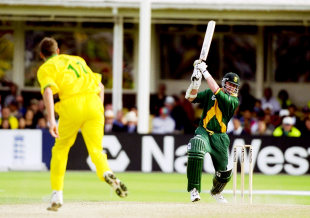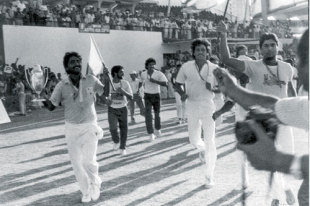Why and when players feel under the cosh, what it does to them, and how to deal with it
October 8, 2009

| ||
| Related Links | ||
Ever wonder why Chetan Sharma couldn't bowl a last-ball yorker in the Sharjah final against Pakistan all those years ago and instead bowled a low full-toss that Javed Miandad promptly hit for a six to win the match? After all, Sharma was extremely effective with the old ball in the slog overs. He could produce yorkers almost at will, which was why he was entrusted with the job of bowling that crucial final over. Let me try and put you in the shoes of players at such moments.
Scene 1 Imagine you're fielding at long-off in a friendly game at the Eden Gardens. The batsmen stroll a single. You field the ball without fuss and throw it. It's a routine drill for you.
Scene 2 Imagine you're doing the above on your first-class debut. There are senior players, perhaps even selectors, watching you and you want to do it absolutely right. You keep your eyes on the ball and ensure that you don't fumble, and promptly return the ball to the bowler. You feel some nerves but nothing that you can't handle.
Scene 3 Now change the colour of the jersey to India's blue and imagine playing in front of 100,000 people. The noise in the stadium is deafening. You can hear the people in the stands behind you shout as they realise the ball is coming their way. The batsmen are pressing for a non-existent second run to put pressure on you. But you hold your nerve, pick the ball cleanly, throw it back and heave a sigh of relief.
Scene 4 It's the last ball of a final between India and Pakistan. The opposition needs two runs to win the game. The ball is hit in your direction. They're running hard and you need to pounce, collect it cleanly and make a solid and accurate return to ensure a run-out. All of this happens in no more than a few seconds, but they seem to last forever. One slip-up could cost your team the match, and with it the trophy. It may even cost you your place in the side. You could be a veritable pariah to the watching millions.
Nothing is fundamentally different between those four scenarios - except for the degree of pressure involved. The ground remained the same, so did the power with which the shot was hit, and the weight of the ball. But there's a huge difference between fielding in a friendly and in an international match, especially when a match, trophy or career is at stake.
I use fielding as an example because luck plays a smaller role in fielding than it does in other disciplines. You might get a good ball while batting or the batsman might hit a great shot off a good ball you bowl, but with fielding there are few such issues.
| Ricky Ponting says that unless playing a certain shot or bowling a certain ball hasn't become a habit, it's almost impossible to produce it under pressure. For example, if a lofted shot over covers is your get-out-of-jail shot you must perfect the shot in practice | |||
Fear of failure
Cricketers, like everyone else, have an inherent desire to succeed. We are taught the consequences of failure from an early age. If you don't perform, you're dropped from the side and you have to endure criticism from peers, coaches and others. The desire to succeed gives birth to the fear of failure. It's this fear that breeds nervousness, especially at the beginning of an innings. Only a few can remain calm while facing their first ball or running in to bowl their first delivery. There's always the fear of things going awfully wrong. It isn't only public failure that haunts a cricketer but also the knowledge that that failure could mean the end of the road for him at that particular level.
I remember playing for the Board President's XI against New Zealand just before my Test debut. I had had a knee surgery a few months before that, and it was my first competitive game in six months. The only thought that occupied my mind while facing Ian Butler was that I had to survive the first ball somehow and not get out for a duck. Logically there isn't much difference between getting out for 0 and for 1, but the mind seldom follows logic. The obsession with getting off the mark exists at all levels.
The higher the stakes, the bigger the fear. The fear of failure is at its pinnacle when you're playing for your place in the side. Both Dinesh Karthik and Abhishek Nayar found themselves in such a situation against West Indies in the Champions Trophy, and the effect was quite visible. Both would probably have played differently at any other time in their careers, but not on that day. They were circumspect and did everything in their power to avoid failure.
Fear of success
A tennis player committing unforced errors and double faults while serving for the match, a golfer missing a straightforward putt on the 18th hole, and a batsman taking a non-existing single on 99 to reach his hundred are common.
Anticipating success, and the accolades that come with it, coupled with the fear of ruining all the hard work that has been put in, makes a player nervous near the finishing line. The mind is in two places: one part wanders into the future, contemplating the kudos, while the other is scared of stumbling at the last hurdle. As a result, the execution of simple skills becomes difficult and the ability to think rationally deserts the individual. In hindsight, I must have felt the same way when I swept Stuart MacGill on 48 in the Melbourne Test of 2003. I don't usually play the sweep shot, but the eagerness to score a fifty did me in.

| ||
Lance Klusener and Allan Donald did something similar in the 1999 World Cup semi-final against Australia. Klusener could have hit a boundary with ease, and he had two more deliveries to go, but it all ended in a messy run-out.
Pressure from external circumstances
There are times when it's not the match situation that puts pressure on you. Remember Sachin Tendulkar's sleepless nights before the India-Pakistan clash in the 2003 World Cup? He doesn't lose sleep over every international game, but that wasn't any old game - it was an India-Pakistan clash in the biggest tournament of them all. I'm sure English and Australian cricketers face the same situation during the Ashes. In these cases it's not the quality of the opposition that puts you under pressure but the importance of the occasion and the expectations of people back home.
Individuals respond differently to pressure
The pressure that you feel has a lot to do with the form you are in and also the match situation. The pressure you feel while batting on the first day of a Test match is quite different from that which you feel while batting to save a Test in the fourth innings.
Two individuals facing the same opposition react differently thanks to the sort of form they are in. In the third Test match in Chennai against Australia in 2004-05, India had to bat only a few overs at the end of the fourth day. Virender Sehwag, who was in sublime form, saw it as an opportunity to score a quick 20, since the field was attacking, considering it was a short session. On the contrary Yuvraj Singh couldn't wait to get off the park. But it doesn't really tell you anything about the attitude or the mental toughness of either batsman because the same Sehwag wasn't keen to bat against the lesser bowlers of Maharashtra in a less important Ranji Trophy game at a time when he couldn't get the ball off the square.
How does on handle pressure?
Different players have different ways of dealing with pressure.
Brendon McCullum says that one must rein oneself in under pressure. Instead of going for a big heave when you're not seeing the ball well and your feet are not moving, take a single to get the other batsman on strike. Doing that gives you time to settle down and find form.
| The desire to succeed gives birth to the fear of failure. It's this fear that breeds nervousness, especially at the beginning of an innings | |||
Ricky Ponting says that the only way to do well under pressure is to work hard in the nets. While he agrees that quality of practice is very important, he believes the quantity also plays a big role. He adds that unless playing a certain shot or bowling a certain ball hasn't become a habit, it's almost impossible to produce it under pressure. For example, if a lofted shot over covers is your get-out-of-jail shot, you must perfect it in practice to execute it to perfection in a match.
The importance of detachment
Players who are able to detach themselves from the importance of the occasion are better equipped to handle pressure. John Buchanan spoke to us at Kolkata Knight Riders about the need to disconnect from the hype created around the game in order to perform to potential.
We, as players, tend to go with the flow in big matches and at crucial situations. One feels pressured to hit a big shot as soon as the asking-rate goes over seven. Even though the situation is not as alarming as it sounds - because seven an over is achievable with sensible cricket and a few calculated risks - the pressure gets to people.
S Sriram once told me what to do in situations like this: "Postpone the desire to hit a big one by 10 minutes and play percentage cricket till then. But if you still feel the need to go for the jugular after 10 minutes, you should." The idea here is to think rationally instead of going with the flow and hitting a cross-batted slog off a good ball. One must try to play to one's strengths.
Bishan Bedi used to tell us that pressure is something you put on yourself. The scoreboard just shows digits and we get nervous or confident depending on how we read them. It sounds ridiculously simple, but it isn't.
Feeling under pressure is a state of mind, and I think staying in the present and playing on the merit of the ball works for me. Sharma and Miandad were at the opposite ends of the spectrum on that particular ball in that fateful match. One couldn't think or perhaps couldn't execute his plan under pressure, while the other not only thought rationally but also achieved an extremely difficult task. That's what pressure does to people. And how they handle and react to pressure is what separates great players from good ones.
Have more than one Hotmail account? Link them together to easily access both.
No comments:
Post a Comment